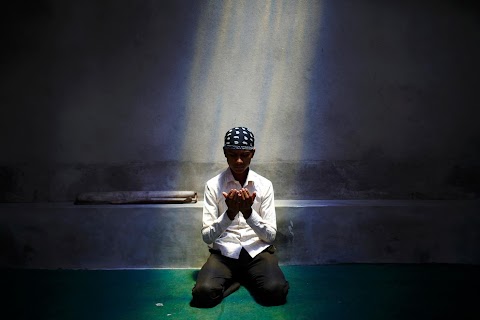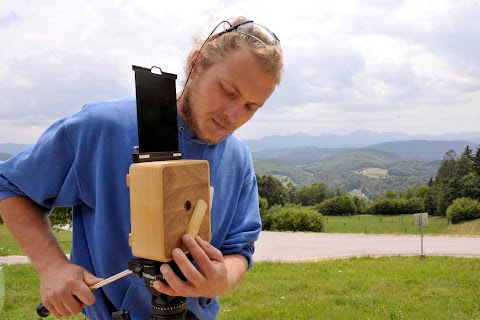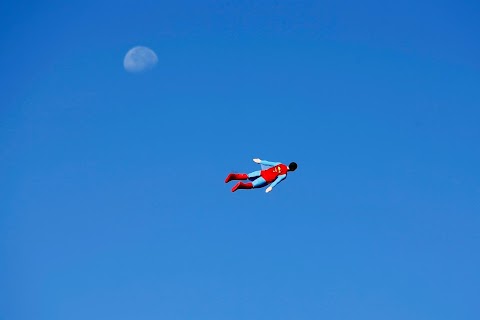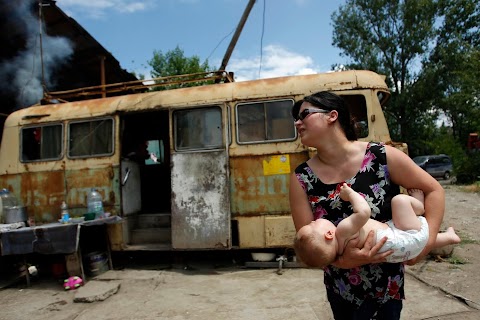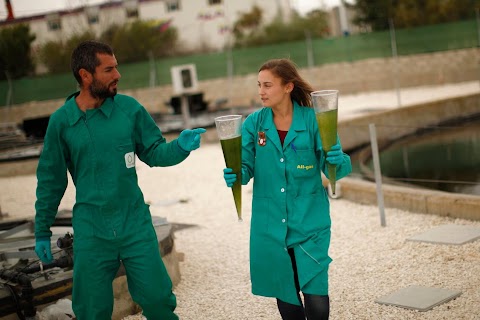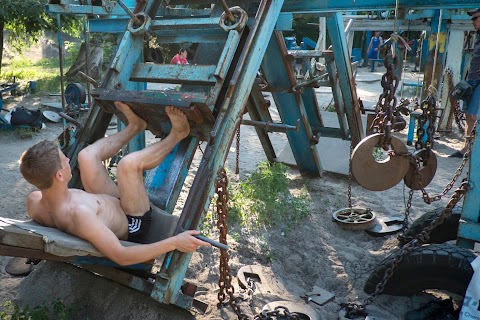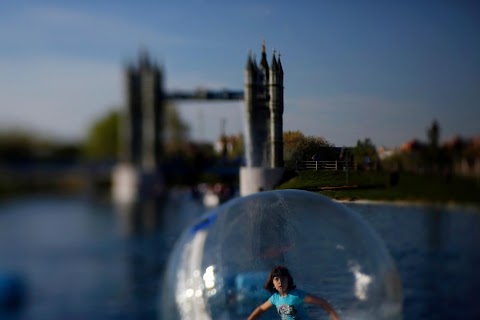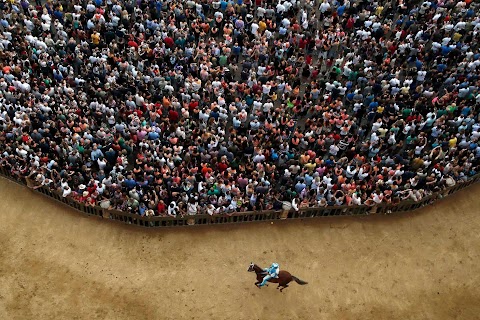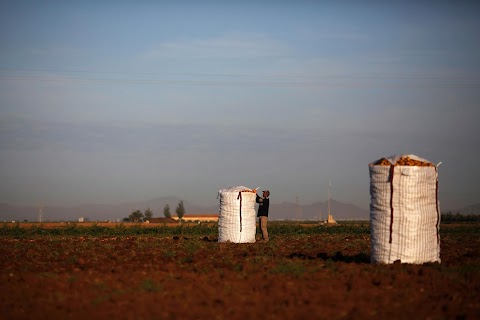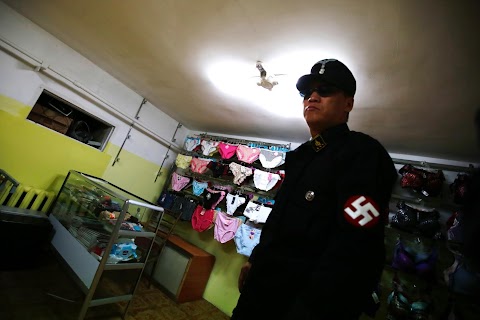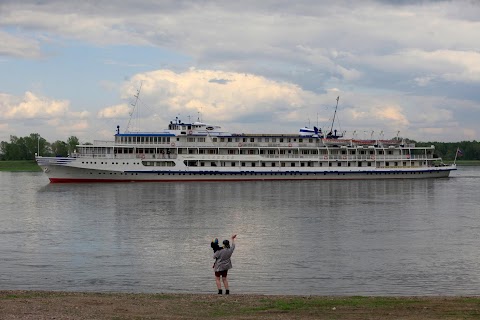
Siberia's river of life
 Ilya Naymushin
Ilya Naymushin
Dwarfed by the scale of the ship passing by them, a woman and child wave at the passengers on board. Yet even this sizeable vessel is just a tiny speck on the vast waterway it is motoring down: the Yenisei River. The Yenisei is one of the largest river systems in the world, rising in Mongolia and flowing right to the Arctic Ocean. It cuts Siberia in two, and is vital to those who live on its banks, providing a source of work, transport, fresh water and more, as well as sculpting the culture of the region.

"Yenisei is the river of life," reads a sign at a repair base for the Yenisei River Shipping Company in the Siberian village of Podtyosovo. Workers here spend much of their time patching up vessels dating from the Soviet era, as well as recycling completely unserviceable ships into scrap metal. Old boats from the Russian federal fleet stand here rusting, in the place where they have been moored since the disintegration of the Soviet Union.

Over the river's long course it flows past land rich in natural resources, including oil, coal, metal ores and timber. Russia's largest hydroelectric power station, Sayano-Shushenskaya, pictured here, is also located on the Yenisei, with the second largest hydroelectric plant a few hundred kilometres downstream.

As the river snakes across Siberia, a number of different isolated communities can be found along its banks. Among them are Orthodox Old Believers, whose ancestors came to the region in the 17th Century, fleeing persecution after they opposed reforms to the Orthodox Church.
Dmitry Subbotin, a member of the community, is pictured steering a traditional, flat-bottomed wooden boat on a tributary to the Yenisei near the village of Makarovo, where a number of Old Believers live in relative seclusion. But Subbotin's clothes - a jacket from a fishing shop and a pair of sports trousers, rather than home-woven fabrics - also hint at how contact between this community and the rest of the world is increasing.
Slideshow

A patrol boat cruises along the Yenisei River in the Sayano-Shushensky nature reserve, known as the habitat of a small population of snow leopards. The expedition was organised by the reserve so that its employees could survey the area's wildlife and scout for possible ecotourism locations.

A man clambers over logs left after a flood receded from the reservoir near the Sayano-Shushenskaya hydroelectric power station. Employees from the plant collect logs that float down the Yenisei River so that they can be recycled.

An abandoned vessel is left on the bank of the Yenisei outside the city of Krasnoyarsk - a common sight as shipping on the river declines.

Abandoned ships from the Russian federal fleet are moored at a Yenisei River Shipping Company repair base in the village of Podtyosovo.

Sparks fly as a worker welds the bottom of an old barge at the repair base, where many Soviet-era vessels are fixed up.

Passengers board a tax-free ferry on the riverbank.

Igor Chernyayev, an officer on the old passenger ship the "Mikhail Lermontov", stands at the wheel of the boat, which will soon go out of service.

A mechanic onboard the "Mikhail Lermontov", built in former Czechoslovakia in the late 1950s, works in an engine-room during preparations for a voyage.

Vladimir Semyonov, an electrician on the "Victor Astafiev" bulk-oil vessel, smiles from the command bridge deck as the ship undergoes repairs.

A woman sunbathes on an island in the middle of the Angara River, which flows into the Yenisei.

A member of an amateur local folk group, who wears a leaf as a hat, performs during celebrations in Ust-Kem village, next to the Yenisei River.

Children in a folk group from the Siberian town of Kodinsk rehearse the Huzul national dance on the banks of the Yenisei, before performing at the 21st interregional "Festival by the Marvellous Mountains".
"Russia is a country of contrasts and Yenisei has some of everything."
“Yenisei is the river of life.” So read a sign I saw at the Yenisei River Shipping Company’s repair base in the remote Siberian village of Podtyosovo.
Currently, workers at the factory spend most of their time repairing vessels and barges constructed 20-50 years ago during the Soviet era. They cut rusty pieces out of the boats, and weld new parts in their place, while others recycle absolutely unserviceable boats into scrap metal. It’s a sad sight, looking at the rusty ships on the bank and on the water, moored by the same corroded cables.
This is just one snapshot from the banks of the Yenisei River, which divides Siberia in two. On the left bank is Western Siberia, with its great plains stretching out from the Ural mountains. On the right bank is Eastern Siberia with its mountain "Taiga," or boreal forests, that carry on from here to the Pacific coast.
Yenisei is one of the largest river systems in the world and the largest in Russia, rising in Mongolia and flowing into the Arctic Ocean. It is the life artery for the residents who populate its banks. The huge river influences the economic structure of the region, feeds its inhabitants, and provides work, transport, communications, clean water and pure air for the more than three million people living around it in the Krasnoyarsk region, and within the Russian federal subjects of Khakassia and Tuva.
When the Yenisei starts, it passes through camel-populated parts of Mongolia, Tuva’s semi-deserts and the area of the steppes. Nomads, whose customs have changed little since the times of Genghis Khan are to be found here too. Some 4,200 km to the north, at a river mouth on the Taimyr peninsula, where the Yenisei joins the Arctic Ocean, live polar bears and nomad natives, whose rhythm of life is synchronised with the migration of thousands of reindeers.
Between these two areas lie the “Seas of the Taiga”, where the earth is stuffed with rich resources. The largest Russian cities owe some of their riches to the Yenisei River banks. Norilsk Nickel, the world's largest nickel and palladium miner, extracts metal ores here, including copper, nickel and platinum. Rusal, the globe's largest producer of aluminium, is here too. So too is Polus Gold, the largest Russian gold-mining company.
The river also flows near the Vankor oil deposit – which will remain a source of wealth for Russia’s top oil producer, Rosneft, for many years to come. The stocks of coal are the richest in the country, and the area is also a source of valuable wood. The two largest hydroelectric power stations in Russia - Sayano-Shushenskaya and Krasnoyarskaya - are constructed on the Yenisei River.
Russia is a country of contrasts and Yenisei has some of everything. Anyone who does not wish to live in an urban environment can always find a place here so far from civilisation that they will not meet anyone else for months.
You can lead a natural life on Yenisei’s shores, fishing, hunting, collecting berries, mushrooms and healing herbs. This May, during an ecological trip through the Sayano-Shushensky nature reserve on a motorboat, we met one such hermit on a tributary to the Yenisei in the Sayan mountains. He threw us a few big fish and told us that we were the first people he had seen that year!
Among those who lead secluded lives here are Orthodox Christian Old Believers, who came to Siberia in the mid-17th Century fleeing mass persecution after they opposed reforms to the church. The Old Believers hid in the boundless open space of the Asian part of Russia, and their descendants are living in the remote Taiga villages to this day, continuing with their old traditions.
I have visited members of an Old Believer community in the village of Makarovo, 450 km to the north of the city of Krasnoyarsk, where I live. In my experience they are strong and kind, laconic and hardworking, with a highly developed sense of spirituality. They conduct their lives closed off from society and don’t impose their philosophy on anyone, but they are always ready to come to your aid.
Over May, June and July, while working on this story, I visited some of the most contrasting parts of the Yenisei River - from Tuva, where the channel is just 270 metres wide, hemmed in by rocky mountains, to Middle Yenisei, to the north, where the river is over 2 km wide.
If you were to reach the Arctic belt, where the Yenisei takes on the full force of all its tributaries, there are parts of the river where it is impossible to see the opposite bank, and waves reach 2.5 metres. Here, it is the deepest river in Russia.
As I have been travelling this river, transport is a theme that has fascinated me. Twenty years ago, the Yenisei River Shipping Company had more than 800 ships at its disposal. Today, it has just a quarter of that number. In general, the decline of shipping along the river is even greater. Abandoned rusty barges and boats are visible over its whole extent.
Officials explain that in a modern economy, the same amount of transport along the river is no longer required; aircraft and motor vehicles have superseded slow and expensive river liners.
The passenger steamship "Mikhail Lermontov," which I used to travel from Krasnoyarsk to the north, only has a licence to run until the end of this navigation season. It was constructed in former Czechoslovakia in 1957 and is the last steamship of its type on the Yenisei. After it goes out of service, there will only be two classic passenger liners left on the river, and they have both reached quite a ripe old age too.
I spent some time in the “Mikhail Lermontov” with the officer Igor Chernyayev, and I watched as he operated the vessel. Igor, whose father also works on the river as the captain of a new, high-speed passenger ship, is worried about his own future. After "Lermontov" stops functioning, he will have to search for a new job.
And yet the water keeps flowing, and you can still see that sign: “Yenisei is the river of life”. It really is. And it’s true for me too. More than half of the photos that I send in to Reuters are connected, directly or indirectly, with the Yenisei River.
(Writing by Ilya Naymushin; Editing by Hannah Vinter)

A woman rides a bicycle after visiting a food shop set up inside the "Raketa", a former Soviet-made high-speed passenger ship, in the village of Podtyosovo by the Yenisei.
